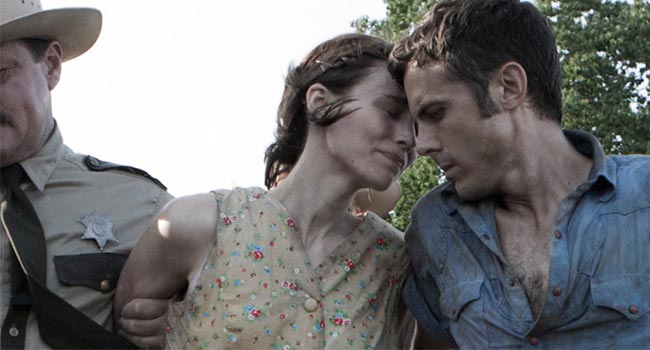
The breathtaking imagery, the superb performances, the tasteful narrative, the perfectly captured moments—ultimately don’t add up to greatness.

The breathtaking imagery, the superb performances, the tasteful narrative, the perfectly captured moments—ultimately don’t add up to greatness.
There’s no way around it. David Lowery’s darkly romantic Texas tale, Ain’t Them Bodies Saints (love the title), starring Casey Affleck and Rooney Mara as bandit lovers, begs comparison to the films of Terrence Malick, one of the cinematic masters of our era. It isn’t bad company to be in—the comparisons are a high compliment, actually—but being examined next to the very best can diminish a film’s individuality. With Ain’t Them Bodies Saints, Lowery leaves me no choice.
Lowery’s outlaw tale owes a bit of its spirit to Badlands. Just a bit, though—it owes even more to Arthur Penn’s Bonnie and Clyde. The Malick comparison that’s hugely unavoidable is the film’s unmistakable resemblance to Days of Heaven—both are stunning with sun-soaked natural lighting, a melancholy Texas setting, and ephemeral editing that flows like the breeze. Though the film feels derivative on certain levels, there’s also a sense that Lowery is staying true to himself here. He does have his own voice—it just happens to be one of a film-lover and student of the game who’s been touched by Malick’s work. Other influences are clear—‘70s road films, Paul Thomas Anderson, Cormac McCarthy, and Robert Altman (the latter two of which Lowery has frequently cited as influences)—but Malick’s rings the truest, or at least the loudest.
Like AMC’s The Walking Dead, Ain’t Them Bodies Saints shows you what happens after most movies cut to credits. The setting is a tiny town in Texas, and we start at the end—after a heist gone wrong, Bob Muldoon (Affleck) and Ruth Guthrie (Mara), a dusty pair of outlaw lovebirds (Ruth is carrying Bob’s child) are arrested after a classic shootout with the police. Patrick Wheeler (Ben Foster, an excellent character actor who is uncharacteristically soft-spoken and tender here), one of the cops on the scene, is shot by Ruth, but Bob takes the fall and is sentenced to 25 years in prison. Cut to four years later, and Bob’s escaped from prison to return to and run off with Ruth and his daughter, Sylvie (now 4 years old). Of course, we see nothing of the breakout, as Ain’t Them Bodies Saints is all about emotion as a result of action, not the action itself. The town is alerted of his escape, and Wheeler takes to keeping an eye on Ruth and Sylvie in anticipation of Bob’s impending arrival.

Ruth has come to terms with the fact that she and Bob’s relationship is a doomed one, but she and Sylvie are Bob’s only desire, and still he comes. Bob’s unfettered determination to return to his family is moving, if a little tragic. Affleck and Mara have precious little onscreen time together, but fascinatingly enough, their chemistry is the driving force of the film. In true Malick-ian fashion, they exchange whispers of devotion and mythic romance in thick Texas accents as they’re drenched in melancholic magic-hour sunrays. Though their exchanges are few, Affleck, Mara, and Lowery (who also penned the film) make every word, every longing glance, count. We feel their longing whether they’re both on-screen or not.
Lowery makes time for tender moments like Ruth singing Sylvie an achingly sweet lullaby or Bob laying is head on Ruth’s lap in their parked truck late at night. This is a quiet, almost muffled film, relying on atmosphere to convey the brunt of the emotion. Dialogue is sparse by design. Keith Carradine (a throwback to a time when Hollywood was full of men, not boys in men’s clothes) plays Skerritt, Bob’s adopted father and guardian to Ruth and Sylvie. He says things once, clearly and with authority, because he doesn’t care to repeat himself.
Lowery and cinematographer Bradford Young communicate most of their ideas not through plot, but through dark, dark imagery—the murky, smudged lighting and thick, almost impossibly black nighttime scenes (honestly—I don’t know how they shot them) reflect Bob and Ruth’s bleak and ill-fated future. The rusty, dusty atmosphere is so palpable it’s almost tactile—when Bob kicks up piles of dust while evading the police, you almost want to cough. Another nice touch is that we’re never given a definitive time period in which the story takes place, which lends the film a sense of timelessness.
Here’s the thing—all signs point to this movie being a larger-than-life, soul-rattling Americana tale like Malick is known to gift us with, but the signs lead nowhere. The components of the film—the breathtaking imagery, the superb performances, the tasteful narrative, the tender, perfectly captured moments—ultimately don’t add up to greatness. Malick can shake emotions buried inside us that we didn’t even know we had. He offers grand ideas that can shift your state of mind or even your values. With Ain’t Them Bodies Saints, Lowery has all the pieces to the puzzle, but just can’t put them together like the master can, though his creation is undeniably beautiful in its own right. Perhaps the darkness that pervades the film is the long shadow of Malick, watching over his apprentice as he struggles with his homework. I imagine Lowery would receive an encouraging wink and a B-.